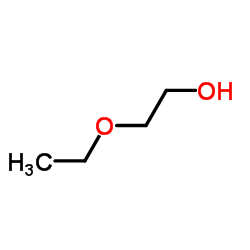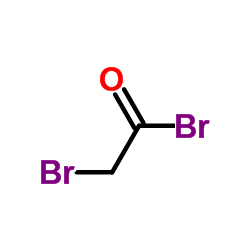2-ethoxyethyl 2-bromoacetate
Modify Date: 2025-08-25 17:44:32

2-ethoxyethyl 2-bromoacetate structure
|
Common Name | 2-ethoxyethyl 2-bromoacetate | ||
|---|---|---|---|---|
| CAS Number | 56521-73-4 | Molecular Weight | 211.05400 | |
| Density | 1.401g/cm3 | Boiling Point | 232.6ºC at 760 mmHg | |
| Molecular Formula | C6H11BrO3 | Melting Point | N/A | |
| MSDS | N/A | Flash Point | 94.5ºC | |
| Name | 2-ethoxyethyl 2-bromoacetate |
|---|---|
| Synonym | More Synonyms |
| Density | 1.401g/cm3 |
|---|---|
| Boiling Point | 232.6ºC at 760 mmHg |
| Molecular Formula | C6H11BrO3 |
| Molecular Weight | 211.05400 |
| Flash Point | 94.5ºC |
| Exact Mass | 209.98900 |
| PSA | 35.53000 |
| LogP | 0.96100 |
| Index of Refraction | 1.458 |
| InChIKey | PDBWYOYFNRASDC-UHFFFAOYSA-N |
| SMILES | CCOCCOC(=O)CBr |
Synonym: Section 2 - COMPOSITION, INFORMATION ON INGREDIENTS
Risk Phrases: 20/21/22 Section 3 - HAZARDS IDENTIFICATION EMERGENCY OVERVIEW
Harmful by inhalation, in contact with skin and if swallowed. Potential Health Effects Eye: May cause eye irritation. Skin: May cause skin irritation. Harmful if absorbed through the skin. Ingestion: Harmful if swallowed. May cause irritation of the digestive tract. Inhalation: Harmful if inhaled. May cause respiratory tract irritation. Chronic: Not available. Section 4 - FIRST AID MEASURES Eyes: Flush eyes with plenty of water for at least 15 minutes, occasionally lifting the upper and lower eyelids. Get medical aid. Skin: Get medical aid. Flush skin with plenty of water for at least 15 minutes while removing contaminated clothing and shoes. Ingestion: Get medical aid. Wash mouth out with water. Inhalation: Remove from exposure and move to fresh air immediately. If not breathing, give artificial respiration. If breathing is difficult, give oxygen. Get medical aid. Notes to Physician: Section 5 - FIRE FIGHTING MEASURES General Information: As in any fire, wear a self-contained breathing apparatus in pressure-demand, MSHA/NIOSH (approved or equivalent), and full protective gear. Extinguishing Media: Use water spray, dry chemical, carbon dioxide, or chemical foam. Section 6 - ACCIDENTAL RELEASE MEASURES General Information: Use proper personal protective equipment as indicated in Section 8. Spills/Leaks: Absorb spill with inert material (e.g. vermiculite, sand or earth), then place in suitable container. Section 7 - HANDLING and STORAGE Handling: Avoid breathing dust, vapor, mist, or gas. Avoid contact with skin and eyes. Storage: Store in a cool, dry place. Store in a tightly closed container. Section 8 - EXPOSURE CONTROLS, PERSONAL PROTECTION Engineering Controls: Use adequate ventilation to keep airborne concentrations low. Exposure Limits CAS# 56521-73-4: Personal Protective Equipment Eyes: Not available. Skin: Wear appropriate protective gloves to prevent skin exposure. Clothing: Wear appropriate protective clothing to prevent skin exposure. Respirators: Follow the OSHA respirator regulations found in 29 CFR 1910.134 or European Standard EN 149. Use a NIOSH/MSHA or European Standard EN 149 approved respirator if exposure limits are exceeded or if irritation or other symptoms are experienced. Section 9 - PHYSICAL AND CHEMICAL PROPERTIES Physical State: Not available. Color: Not available. Odor: Not available. pH: Not available. Vapor Pressure: Not available. Viscosity: Not available. Boiling Point: Not available. Freezing/Melting Point: Not available. Autoignition Temperature: Not available. Flash Point: Not available. Explosion Limits, lower: Not available. Explosion Limits, upper: Not available. Decomposition Temperature: Solubility in water: Specific Gravity/Density: Molecular Formula: C6H11BrO3 Molecular Weight: 211.06 Section 10 - STABILITY AND REACTIVITY Chemical Stability: Not available. Conditions to Avoid: Incompatible materials. Incompatibilities with Other Materials: Strong oxidizing agents. Hazardous Decomposition Products: Carbon monoxide, carbon dioxide, hydrogen bromide. Hazardous Polymerization: Has not been reported Section 11 - TOXICOLOGICAL INFORMATION RTECS#: CAS# 56521-73-4 unlisted. LD50/LC50: Not available. Carcinogenicity: 2-Ethoxyethyl bromoacetate - Not listed by ACGIH, IARC, or NTP. Section 12 - ECOLOGICAL INFORMATION Section 13 - DISPOSAL CONSIDERATIONS Dispose of in a manner consistent with federal, state, and local regulations. Section 14 - TRANSPORT INFORMATION IATA No information available. IMO No information available. RID/ADR No information available. Section 15 - REGULATORY INFORMATION European/International Regulations European Labeling in Accordance with EC Directives Hazard Symbols: XN Risk Phrases: R 20/21/22 Harmful by inhalation, in contact with skin and if swallowed. Safety Phrases: S 36/37 Wear suitable protective clothing and gloves. WGK (Water Danger/Protection) CAS# 56521-73-4: No information available. Canada None of the chemicals in this product are listed on the DSL/NDSL list. CAS# 56521-73-4 is not listed on Canada's Ingredient Disclosure List. US FEDERAL TSCA CAS# 56521-73-4 is not listed on the TSCA inventory. It is for research and development use only. SECTION 16 - ADDITIONAL INFORMATION N/A |
|
~59% 
2-ethoxyethyl 2... CAS#:56521-73-4 |
| Literature: Morrissey, Saibh; Pegot, Bruce; Coleman, Deborah; Garcia, M. Teresa; Ferguson, Damien; Quilty, Brid; Gathergood, Nicholas Green Chemistry, 2009 , vol. 11, # 4 p. 475 - 483 |
| Precursor 2 | |
|---|---|
| DownStream 0 | |
| 2-ethoxyethyl bromoacetate |
| EINECS 260-240-9 |
| Acetic acid,2-bromo-,2-ethoxyethyl ester |

